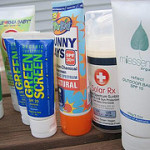How to Choose a Safe Sunscreen
 Ingredients do matter when choosing a sunscreen. Many products on the market contain synthetic fillers and chemical preservatives that can act as hormone-disrupting compounds in the body. It is important to know the facts about sunscreen marketing and learn how to read labels. Let’s start with the basics.
Ingredients do matter when choosing a sunscreen. Many products on the market contain synthetic fillers and chemical preservatives that can act as hormone-disrupting compounds in the body. It is important to know the facts about sunscreen marketing and learn how to read labels. Let’s start with the basics.
Ultraviolet Radiation
If you have ever gotten a sunburn on a cloudy day, it is from the deeply penetrating UVA rays. These rays are harmful to the skin and can cause wrinkles, aging, and cancers such as malignant melanoma. They can penetrate through glass and through skin. Prior to this year, the FDA did not require sunscreen manufacturers to have UVA filters, however that changed this year. The FDA just released new regulations requiring sunscreens to prove they filter out both UVA and UVB rays. If they don’t protect agains both groups of rays then the SPF (sun protection factor) should be listed below 15. The FDA also proposed capping the highest SPF value at 50, unless companies can prove a higher rating. Lydia Velazquez, PharmD, in FDA’s Division of Nonprescription Regulation Development reports:
“Our scientific understanding has grown. We want consumers to understand that not all sunscreens are created equal. This new information will help consumers know which products offer the best protection from the harmful rays of the sun,” Velazquez says. “It is important for consumers to read the entire label, both front and back, in order to choose the appropriate sunscreen for their needs.” (FDA Sheds Light On Sunscreens)
UVB rays are considered burn rays and are the primary cause of sunburn and non-melanoma skin cancers such as squamous cell and basal cell carcinoma.
Sun Protection Factor (SPF)
SPF listed on the sunscreen bottle corresponds to the length of time that you can stay outside in the sun without risk of sunburn. You can calculate your recommended SPF (www.lavera.com) Sun protection also depends on your skin type.
- Fair skin = 10 minutes
- Olive skin = 15 minutes
- Dark skin = 20 minutes
The formula for calculating your sun protection time before burn is skin type multiplied by SPF number. For example, a fair skin person using a sunscreen SPF of 15 (10 x 15 = 150) would have 150 minutes or 2.5 hours of sun protection.
The Difference Between Physical and Chemical Protection
Chemical sunscreen blockers are absorbed into the skin and they disperse rays. Sunscreens typically contain several active ingredients as no single chemical ingredient can block the entire UV spectrum. The majority of the chemical compounds work only against UVB rays. Some examples include:
- Benzophenones (dixoybenzone, oxybenzone)
- PABA and PABA esters (ethyl dihydroxy propyl PAB, glyceryl PABA, p-aminobenzoic acid, padimate-O or octyl dimethyl PABA)
- Cinnamates (cinoxate, ethylhexyl p-methoxycinnamate, octocrylene)
- Salicylates (ethylhexyl salicylate, homosalate, octyl salicylate)
- Digalloyl trioleate
- Menthyl anthranilate
- Avobenzone
Physical or mineral sun blocking agents lay on the skin and act as a barrier that reflects both UVA and UVB rays. Examples include:
- Titanium dioxide
- Zinc oxide
Safe Sun Protection
The physical or mineral sun blocking ingredients tend to rate well according to the Environmental Working Group sunscreen guide because they block harmful UV radiation without penetrating healthy skin. Unlike other common sunscreen chemicals, zinc and titanium are not allergenic, do not break down in sunlight and do not disrupt the body’s natural hormones.
Ingredients to Avoid
According to Dr. Mercola (What Makes Sunscreens Toxic?) sunscreen ingredients that have potentially harmful affects on the body include:
- Para amino benzoic acid
- Octyl salicyclate
- Avobenzone
- Oxybenzone
- Cinoxate
- Padimate O
- Dioxybenzone
- Phenylbenzimidazole
- Homosalate
- Sulisobenzon
- Menthyl anthranilate
- Trolamine salicyclate
- Octocrylene
Check out Dr. Mercola’s article for more detailed specifics about the health problems associated with these chemicals.
A Word About Vitamin D and the Sun
Sunscreens can decrease your ability to absorb vitamin D from the sun. At least 75% of Americans are vitamin D deficient. Only when the UV index is greater than 3 (which occurs daily in the tropics and during the spring and summer seasons in temperate regions) can adequate amounts of vitamin D can be made in the skin. You need 10 to 15 minutes of sun exposure several times per week to keep your levels optimal. It is recommended that you get at least this much unprotected sun exposure to maintain vitamin D levels.
Source: Dr. Christine Cambareri, ND, owner of Bella Fiore Organic Med Spa in Seattle, Washington.
Four Out Of Five Sunscreens May Be Hazardous To Your Health – Dr. Mercola




